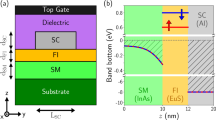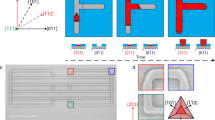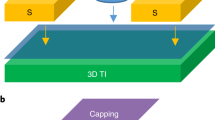Abstract
Semiconductor–superconductor hybrids are widely used to realize complex quantum phenomena, such as topological superconductivity and spins coupled to Cooper pairs. Accessing new, exotic regimes at high magnetic fields and increasing operating temperatures beyond the state-of-the-art requires new, epitaxially matched semiconductor–superconductor materials. One challenge is the generation of favourable conditions for heterostructural formation between materials with the desired properties. Here we harness an increased knowledge of metal-on-semiconductor growth to develop InAs nanowires with epitaxially matched, single-crystal, atomically flat Pb films with no axial grain boundaries. These highly ordered heterostructures have a critical temperature of 7 K and a superconducting gap of 1.25 meV, which remains hard at 8.5 T, and therefore they offer a parameter space more than twice as large as those of alternative semiconductor–superconductor hybrids. Additionally, InAs/Pb island devices exhibit magnetic field-driven transitions from a Cooper pair to single-electron charging, a prerequisite for use in topological quantum computation. Semiconductor–Pb hybrids potentially enable access to entirely new regimes for a number of different quantum systems.
This is a preview of subscription content, access via your institution
Access options
Access Nature and 54 other Nature Portfolio journals
Get Nature+, our best-value online-access subscription
$29.99 / 30 days
cancel any time
Subscribe to this journal
Receive 12 print issues and online access
$259.00 per year
only $21.58 per issue
Buy this article
- Purchase on Springer Link
- Instant access to full article PDF
Prices may be subject to local taxes which are calculated during checkout




Similar content being viewed by others
Data availability
Full data sets for all figures, TEM images, transport data, electronic logbooks and other data that support the findings of this study are available online at https://doi.org/10.17894/ucph.3141b812-a33f-41ed-a732-2a80fcbdb7f4.
References
Lutchyn, R. M. et al. Majorana zero modes in superconductor–semiconductor heterostructures. Nat. Rev. Mater. 3, 52–68 (2018).
Krogstrup, P. et al. Epitaxy of semiconductor–superconductor nanowires. Nat. Mater. 14, 400–406 (2015).
Pendharkar, M. et al. Parity-preserving and magnetic field resilient superconductivity in indium antimonide nanowires with tin shells. Preprint at http://arxiv.org/abs/1912.06071 (2019).
Klinovaja, J. & Loss, D. Time-reversal invariant parafermions in interacting Rashba nanowires. Phys. Rev. B 90, 045118 (2014).
Larsen, T. W. et al. Semiconductor-nanowire-based superconducting qubit. Phys. Rev. Lett. 115, 127001 (2015).
Luthi, F. et al. Evolution of nanowire transmon qubits and their coherence in a magnetic field. Phys. Rev. Lett. 120, 100502 (2018).
Tosi, L. et al. Spin-orbit splitting of Andreev states revealed by microwave spectroscopy. Phys. Rev. X 9, 011010 (2019).
Hays, M. et al. Direct microwave measurement of Andreev-bound-state dynamics in a semiconductor–nanowire Josephson junction. Phys. Rev. Lett. 121, 047001 (2018).
Prada, E. et al. From Andreev to Majorana bound states in hybrid superconductor–semiconductor nanowires. Nat. Rev. Phys. 2, 575 (2020).
Chang, W. et al. Hard gap in epitaxial semiconductor–superconductor nanowires. Nat. Nanotechnol. 10, 232–236 (2015).
Oreg, Y., Refael, G. & von Oppen, F. Helical liquids and Majorana bound states in quantum wires. Phys. Rev. Lett. 105, 177002 (2010).
Lutchyn, R. M., Sau, J. D. & Das Sarma, S. Majorana fermions and a topological phase transition in semiconductor–superconductor heterostructures. Phys. Rev. Lett. 105, 077001 (2010).
Mourik, V. et al. Signatures of Majorana fermions in hybrid superconductor–semiconductor nanowire devices. Science 336, 1003–1007 (2012).
Albrecht, S. M. et al. Exponential protection of zero modes in Majorana islands. Nature 531, 206–209 (2016).
Das, A. et al. Zero-bias peaks and splitting in an Al–InAs nanowire topological superconductor as a signature of Majorana fermions. Nat. Phys. 8, 887–895 (2012).
Deng, M. T. et al. Anomalous zero-bias conductance peak in a Nb–InSb nanowire–Nb hybrid device. Nano Lett. 12, 6414–6419 (2012).
Carrad, D. J. et al. Shadow epitaxy for in situ growth of generic semiconductor/superconductor hybrids. Adv. Mater. 32, 1908411 (2020).
Bjergfelt, M. et al. Superconducting vanadium/indium–arsenide hybrid nanowires. Nanotechnology 30, 294005 (2019).
Shen, J. et al. Parity transitions in the superconducting ground state of hybrid InSb–Al Coulomb islands. Nat. Commun. 9, 4801 (2018).
Vaitiekenas, S. et al. Flux-induced topological superconductivity in full-shell nanowires. Science 367, eaav3392 (2020).
Aasen, D. et al. Milestones toward Majorana-based quantum computing. Phys. Rev. X 6, 031016 (2016).
Paajaste, J. et al. Pb/InAs nanowire Josephson junction with high critical current and magnetic flux focusing. Nano Lett. 15, 1803–1808 (2015).
Güsken, N. A. et al. MBE growth of Al/InAs and Nb/InAs superconducting hybrid nanowire structures. Nanoscale 9, 16735–16741 (2017).
Deng, M. et al. Majorana bound state in a coupled quantum-dot hybrid–nanowire system. Science 354, 1557–1562 (2016).
Sestoft, J. E. et al. Engineering hybrid epitaxial InAsSb/Al nanowires for stronger topological protection. Phys. Rev. Mater. 2, 044202 (2018).
Vaitiekėnas, S. et al. Selective-area-grown semiconductor–superconductor hybrids: a basis for topological networks. Phys. Rev. Lett. 121, 147701 (2018).
Aseev, P. et al. Selectivity map for molecular beam epitaxy of advanced III–V quantum nanowire networks. Nano Lett. 19, 218–227 (2019).
Kjaergaard, M. et al. Quantized conductance doubling and hard gap in a two-dimensional semiconductor–superconductor heterostructure. Nat. Commun. 7, 12841 (2016).
Shabani, J. et al. Two-dimensional epitaxial superconductor–semiconductor heterostructures: a platform for topological superconducting networks. Phys. Rev. B 93, 155402 (2016).
Sau, J. D. & Sarma, S. D. Realizing a robust practical Majorana chain in a quantum-dot-superconductor linear array. Nat. Commun. 3, 964 (2012).
Su, Z. et al. Andreev molecules in semiconductor nanowire double quantum dots. Nat. Commun. 8, 585 (2017).
Krizek, F. et al. Growth of InAs wurtzite nanocrosses from hexagonal and cubic basis. Nano Lett. 17, 6090–6096 (2017).
Gazibegovic, S. et al. Epitaxy of advanced nanowire quantum devices. Nature 548, 434–438 (2017).
Pentcheva, R. et al. Non-Arrhenius behavior of the island density in metal heteroepitaxy: Co on Cu (001). Phys. Rev. Lett. 90, 076101 (2003).
Venables, J. & Spiller, G. in Surface Mobilities on Solid Materials (ed. Binh, V. T.) 341–404 (Springer, 1983).
Vesselinov, M. I. Crystal Growth for Beginners: Fundamentals of Nucleation, Crystal Growth and Epitaxy (World Scientific, 2016).
Thompson, C. V. Solid-state dewetting of thin films. Ann. Rev. Mater. Res. 42, 399–434 (2012).
Gramich, J., Baumgartner, A. & Schönenberger, C. Subgap resonant quasiparticle transport in normal–superconductor quantum dot devices. Appl. Phys. Lett. 108, 172604 (2016).
van Heck, B., Lutchyn, R. M. & Glazman, L. I. Conductance of a proximitized nanowire in the Coulomb blockade regime. Phys. Rev. B 93, 235431 (2016).
Takei, S., Fregoso, B. M., Hui, H.-Y., Lobos, A. M. & Das Sarma, S. Soft superconducting gap in semiconductor Majorana nanowires. Phys. Rev. Lett. 110, 186803 (2013).
Lee, E. J. H. et al. Zero-bias anomaly in a nanowire quantum dot coupled to superconductors. Phys. Rev. Lett. 109, 186802 (2012).
Hansen, E. B., Danon, J. & Flensberg, K. Probing electron–hole components of subgap states in Coulomb blockaded Majorana islands. Phys. Rev. B 97, 041411 (2018).
Klimovskikh, I. I. et al. Spin–orbit coupling induced gap in graphene on Pt(111) with intercalated Pb monolayer. ACS Nano 11, 368–374 (2017).
Calleja, F. et al. Spatial variation of a giant spin–orbit effect induces electron confinement in graphene on Pb islands. Nat. Phys. 11, 43–47 (2015).
Ruby, M., Heinrich, B. W., Peng, Y., von Oppen, F. & Franke, K. J. Exploring a proximity-coupled Co chain on Pb(110) as a possible Majorana platform. Nano Lett. 17, 4473–4477 (2017).
Nadj-Perge, S. et al. Observation of Majorana fermions in ferromagnetic atomic chains on a superconductor. Science 346, 602–607 (2014).
Reeg, C., Loss, D. & Klinovaja, J. Metallization of a Rashba wire by a superconducting layer in the strong-proximity regime. Phys. Rev. B 97, 165425 (2018).
Ménard, G. C. et al. Isolated pairs of Majorana zero modes in a disordered superconducting lead monolayer. Nat. Commun. 10, 2587 (2019).
Ruby, M., Heinrich, B. W., Pascual, J. I. & Franke, K. J. Experimental demonstration of a two-band superconducting state for lead using scanning tunneling spectroscopy. Phys. Rev. Lett. 114, 157001 (2015).
Momma, K. & Izumi, F. VESTA 3 for three-dimensional visualization of crystal, volumetric and morphology data. J. Appl. Crystallogr. 44, 1272–1276 (2011).
Acknowledgements
This work was funded by the Danish National Research Foundation (J.E.S., K.G.-R. and J.N.), European Union’s Horizon 2020 research and innovation programme under grant agreement no. 823717 (ESTEEM3) (L.Z. and E.O.), FETOpen grant no. 828948 (AndQC) (T.K., M.M. and J.N.) and QuantERA project no. 127900 (SuperTOP) (K.G.-R. and J.N.), Villum Foundation project no. 25310 (K.G.-R.), Innovation Fund Denmark’s Quantum Innovation Center Qubiz (D.C. and J.N.), University of Copenhagen (T.K.) and the Carlsberg Foundation (J.N.). J.d.B. acknowledges support by the Netherlands Organisation for Scientific Research (NWO/OCW), as part of the Frontiers of Nanoscience program. We thank M. Bjergfelt, M. Burello, A. Geresdi, T.S. Jespersen, J. Paaske, J.C. Estrada Saldaña and S. Vaitiekenas for useful discussions. C. B. Sørensen and S. Upadhyay are gratefully acknowledged for technical assistance and support.
Author information
Authors and Affiliations
Contributions
T.K., M.M., D.O. and J.N. developed the materials growth and analysis. T.K., M.M., L.Z., E.J. and E.O. performed the TEM imaging. T.K., M.M., D.O. and D.J.C. developed the Pb device processing. T.K., D.O., D.J.C., J.E.S., J.d.B., K.G.-R. and J.N. carried out transport measurements. J.N. supervised the project. All authors contributed to analysing and interpreting the data and to writing the manuscript.
Corresponding authors
Ethics declarations
Competing interests
The authors declare no competing interests.
Additional information
Peer review information Nature Nanotechnology thanks Javad Shabani and the other, anonymous, reviewer(s) for their contribution to the peer review of this work.
Publisher’s note Springer Nature remains neutral with regard to jurisdictional claims in published maps and institutional affiliations.
Extended data
Extended Data Fig. 1 Tunnel spectroscopy of superconducting gap for additional devices.
a, SEM micrograph of a NS device used for tunnel spectroscopy. Backgate voltage, VBG, and/or sidegate voltage, VSG, was used to adjust the chemical potential along the entire nanowire or the exposed InAs junction, respectively. b, Averaged conductance, Gavg, over VSG vs VSD for the data in c. Coulomb-blockade-related resonances for |VSD |> Δ/e are averaged out and superconducting coherence peaks are visible. c–j, Bias spectroscopy of 8 different NS devices as function of VSG or VBG. The conductance lines in the gap of panels f (VBG ~ 9 V) and g (VSG ~ 5.7 V) may be related to a parallel channel, while the conductance features in for example panels h (see also high resolution zoom in k) and j (VBG ~ − 25 V) can be attributed to bound states. For further discussion, see Supplementary Section 4.1.
Extended Data Fig. 2 Magnetic field evolution of the superconducting gap for additional devices.
Conductance, g, vs VSD and B∥ for: a, the same device as in main text Fig. 3 with different gate voltage settings and b–e separate devices with varying Pb thicknesses. In a,c,d the superconducting gap remains hard until the highest measurable B∥ was reached, while in b discrete bound states converge towards VSD = 0. The critical field is reduced for devices with thicker films. f–j, Normalised conductance g/gN (log-scale) vs VSD at zero and finite field for each device, showing that a strong suppression of zero bias conductance persists at finite field. For further discussion, see Supplementary Section 4.1.
Extended Data Fig. 3 InAs/Pb island device in perpendicular magnetic field.
a, False-colored SEM micrograph of an InAs/Pb island device. Yellow and pink, Ti/Au contacts and gates, respectively; Blue, Pb. Perpendicular magnetic field direction is indicated by B⊥. b, Conductance as a function of VG and B⊥ showing evenly spaced Coulomb resonances that split abruptly at B⊥ ~ 0.2 T. Inset shows the same data on a logarithmic scale to highlight the split. c, Differential conductance at zero field as a function of VG and VSD showing evenly 2e-spaced Coulomb diamonds with asymmetric lead coupling. d, Same Coulomb diamonds shown in (c) recorded at B⊥ = 0.4, 0.9 and 2 T. For further discussion, see Supplementary Section 4.2.2.
Supplementary information
Supplementary Information
Supplementary Information, figures and discussion.
Rights and permissions
About this article
Cite this article
Kanne, T., Marnauza, M., Olsteins, D. et al. Epitaxial Pb on InAs nanowires for quantum devices. Nat. Nanotechnol. 16, 776–781 (2021). https://doi.org/10.1038/s41565-021-00900-9
Received:
Accepted:
Published:
Issue Date:
DOI: https://doi.org/10.1038/s41565-021-00900-9
This article is cited by
-
Joule spectroscopy of hybrid superconductor–semiconductor nanodevices
Nature Communications (2023)
-
Recent progress on Majorana in semiconductor-superconductor heterostructures—engineering and detection
Science China Physics, Mechanics & Astronomy (2023)
-
Epitaxial growth of highly symmetrical branched noble metal-semiconductor heterostructures with efficient plasmon-induced hot-electron transfer
Nature Communications (2023)
-
Majorana-like Coulomb spectroscopy in the absence of zero-bias peaks
Nature (2022)
-
Semiconductor-ferromagnet-superconductor planar heterostructures for 1D topological superconductivity
npj Quantum Materials (2022)



